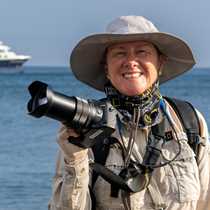Espanola Island
The early-bird kayakers were out not too long after the sun had risen over the east Pacific ocean. We headed for the islet of Gardner, the most prominent of the three islets sitting within what is known as Gardner Bay on the northern shoreline of Espanola Island. Blue, blue sky overhead and turquoise waters as clear as ever. We floated over fish of many hues and shapes, curious to see more details.
After breakfast we returned to Gardner prepared precisely for this: to look at the details with mask, snorkel and fins – fabulous! Myriads of surgeonfish, sergeant majors, white salemas (endemic) and others darted around or hung out, according to temperament. Reef cornet fish lurked on the bottom blending into the paleness of the white sand substrate. A giant hawkfish with its iridescent line markings sat on an isolated rock next to some algae – and blended in very well. The snorkel ended when we reached a cave and looked out from the interior towards the miles of blue ocean beyond.
The white strip of sand that extends a half-mile from one end to the other was broadened this morning by a low tide of extreme proportions. Sea lions and humans alike spread out on the sand to rest and live the moment. We often think these supple marine mammals lie in the most tortuous of positions, but if they had been observing us with equal attention, they would have seen any number of interesting poses being practiced on the beach, some called yoga, others posing for photographs in imitation of sea lions.
For many, the return to the National Geographic Islander was a major swim from shore to ship that covered 360 yards. Many (such as myself) chose to use mask, snorkel and fins in order that we might be prepared in case any interesting marine creature should come our way. We could see the sea floor all the way back to the ship, anchored in 50 feet – extraordinary visibility for Galápagos.
Punta Suarez – a point of land jutting out to the west from the main island of Espanola. Partially up-lifted, bouldery, the southern shoreline cliffs build from the western point southeast, breaking the trade winds when they arrive in April. Sea birds gather to take advantage of the up-draft; frigates, boobies both Nazca and blue-footed, tropicbirds and pelicans cruise at eye-level. An extremely high tide this afternoon packs the marine iguanas and sea-lions up on shore, we have to walk carefully among them, staying on the trail as best we can.
It is a grand finale here on Punta Suarez. We now accept being ignored by the wildlife. We no longer desire our presence to be acknowledged by the iguanas, boobies and sea lions; we leave them be. It is understood that these creatures are playing for high stakes in the game of life: the survival of their offspring. We leave, they stay, just the way it should be.
The early-bird kayakers were out not too long after the sun had risen over the east Pacific ocean. We headed for the islet of Gardner, the most prominent of the three islets sitting within what is known as Gardner Bay on the northern shoreline of Espanola Island. Blue, blue sky overhead and turquoise waters as clear as ever. We floated over fish of many hues and shapes, curious to see more details.
After breakfast we returned to Gardner prepared precisely for this: to look at the details with mask, snorkel and fins – fabulous! Myriads of surgeonfish, sergeant majors, white salemas (endemic) and others darted around or hung out, according to temperament. Reef cornet fish lurked on the bottom blending into the paleness of the white sand substrate. A giant hawkfish with its iridescent line markings sat on an isolated rock next to some algae – and blended in very well. The snorkel ended when we reached a cave and looked out from the interior towards the miles of blue ocean beyond.
The white strip of sand that extends a half-mile from one end to the other was broadened this morning by a low tide of extreme proportions. Sea lions and humans alike spread out on the sand to rest and live the moment. We often think these supple marine mammals lie in the most tortuous of positions, but if they had been observing us with equal attention, they would have seen any number of interesting poses being practiced on the beach, some called yoga, others posing for photographs in imitation of sea lions.
For many, the return to the National Geographic Islander was a major swim from shore to ship that covered 360 yards. Many (such as myself) chose to use mask, snorkel and fins in order that we might be prepared in case any interesting marine creature should come our way. We could see the sea floor all the way back to the ship, anchored in 50 feet – extraordinary visibility for Galápagos.
Punta Suarez – a point of land jutting out to the west from the main island of Espanola. Partially up-lifted, bouldery, the southern shoreline cliffs build from the western point southeast, breaking the trade winds when they arrive in April. Sea birds gather to take advantage of the up-draft; frigates, boobies both Nazca and blue-footed, tropicbirds and pelicans cruise at eye-level. An extremely high tide this afternoon packs the marine iguanas and sea-lions up on shore, we have to walk carefully among them, staying on the trail as best we can.
It is a grand finale here on Punta Suarez. We now accept being ignored by the wildlife. We no longer desire our presence to be acknowledged by the iguanas, boobies and sea lions; we leave them be. It is understood that these creatures are playing for high stakes in the game of life: the survival of their offspring. We leave, they stay, just the way it should be.




